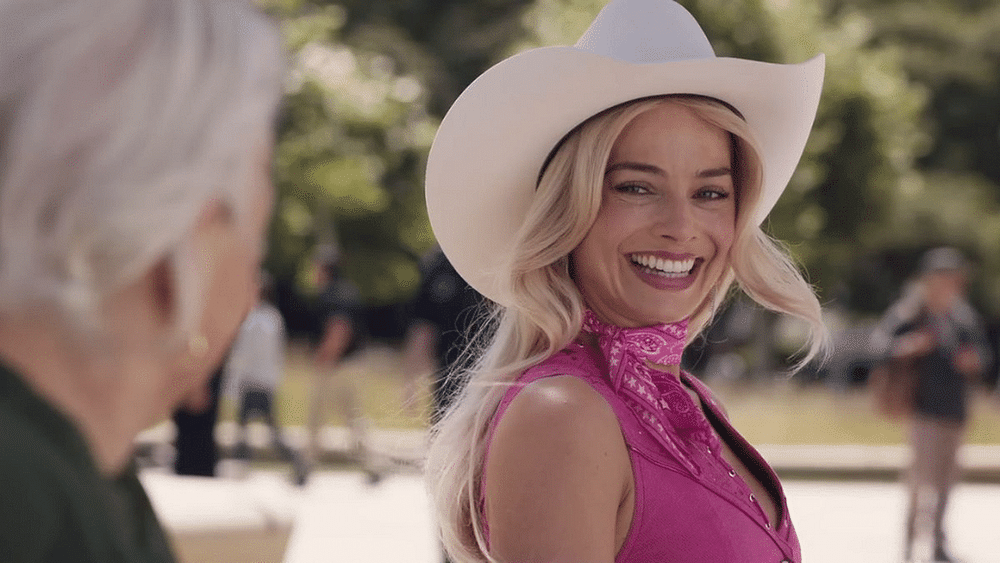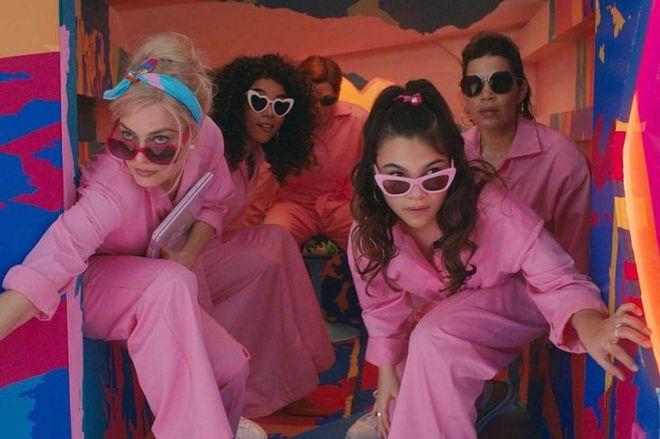The Ending Of 'Barbie,' Explained
Here's how the film brings the iconic doll into the modern world

Barbie is a concept full of contradictions. The fashion doll, which grew over the decades into a global cultural icon, was made to embody the future dreams of generations of little girls heading into adulthood. Now, she has come to life as the star of her first-ever live action film, directed by Greta Gerwig and starring Margot Robbie. Barbie was set to be the hilarious, nostalgic, box-office shattering blockbuster of the year; and it's already exceeding in those areas just halfway through opening weekend. The film is also a nuanced exploration of the anxiety and existential dread of being a woman, leaving viewers with a ton of thematic meaning to unpack once the awe over Barbieland's immersive set and the stars' excellent performances fades away. Let's break down the film's breathtaking ending.
Related article: The Real Barbie Dolls Inspiring Margot Robbie’s Barbie-core Outfits
First we'll run through the basics: the Barbies and Kens of Barbieland are physical manifestations of Mattel's various dolls, who live in an idyllic doll land without certain organic matter, like liquids and genitals. Robbie is Stereotypical Barbie (who we'll just call Barbie with no modifier), and Ryan Gosling is Beach Ken. In their world, Barbies run literally everything, and Kens are their pleasing companions. The men are also second-class citizens, with the women holding all of the important jobs, autonomy, and even homes, as Barbie doesn't even know where they go at night. When Barbie starts to have the unexpected changes seen in the trailer, she and Ken travel to the real world, where they have two very different reactions: Barbie spirals into an existential depression as she begins to question her place in the world, and Ken discovers the wonders of the patriarchy. When he heads back to Barbieland with a head start, he teaches the other Kens sexist ideals and somehow brainwashes the Barbies into becoming trophy situation-ship maids, ahead of a constitutional vote to turn Barbieland into Kenland.

Photo: WARNER BROS
Barbie movie
Eventually Barbie returns to her world, with human Gloria (America Ferrera) and her teen daughter Sasha (Ariana Greenblatt). Gloria has the power to snap the Barbies out of their trance with a monologue about the female side of patriarchy, and once all the Barbies return back to normal, they use some basic romantic manipulation to set the Kens against each other. As the Kens are battling, the Barbies take back their jobs and return the government to normal. In the aftermath, Barbie and Ken have a moment, where they discuss how Ken's antics all came from him having his own identity crisis as he doesn't know who he is outside of being connected to Barbie, who doesn't even like him. Barbie tells him that it's time to figure out who he is without him, and that he doesn't have to be anything other than just Ken.
With this resolution to the film's plot-centered conflict, it seems like a tidy ending. The Mattel CEO (Will Ferrell) who trailed Barbie back into Barbieland declares everything back to normal, but the Barbies decide that Barbieland should change, and at least work towards actual equal rights for Barbies and Kens. Also, Gloria proposes making an Ordinary Barbie doll, which solidifies the film's message that a person should be free to have their own goals, without being told to live up to some universal standard. The CEO initially says no, until an exec confirms it will make a lot of money, and then it's a go because capitalism. Both of these resolutions are slightly lost in the wake of Barbie's final scenes, and honestly they feel a bit superfluous. The true emotional heft of the human world is Gloria and Sasha's relationship, which mends as the mother and daughter begin to understand each other more throughout their Barbieland adventure.
Related article: Dua Lipa’s Barbiecore Look Included A Velvet Minidress And Thigh-High Boots
With every other storyline wrapped up, the movie turns to Barbie, who's still pretty bummed. After exploring the real world, and gaining access to human emotions like fear, anxiety, and "irrepressible thoughts of death," she doesn't know where her place is in Barbieland anymore. She's no longer the perfect, optimistic Stereotypical Barbie, and Normal Barbie doesn't really fit her either. (As the film points out in a fourth wall break, you don't cast Robbie to play the everywoman.) This is when Barbie's guardian angel returns, as the mysterious woman she met at Mattel headquarters walks into the Barbieland crowd. As alluded in the previous scene, this is the Ruth Handler, the creator of Barbie. (Apparently her ghost has been chilling at Mattel since 2002.) Handler invites Barbie to take a walk, and the pair wave goodbye to Barbieland.
The pair enter an empty white void, which sets up the feeling that the old Barbie has died and is heading into a new stage of life (think the Harry and Dumbledore scene from the end of Deathly Hallows). Barbie tells her literal creator her worries about where she goes from here, and admits that she doesn't feel like a Barbie anymore. This is where we hear the lovely line from the trailer, where Ruth tells Barbie, "Humans only have one ending. Ideas live forever." Ruth also admits that she created the doll at a time where feminine ideals were different, saying, "We must stand still so our daughters can look back and see how far they’ve come."

Photo: WARNER BROS
Barbie movie
There's two things Barbie has learned throughout her life-upending adventure. First, the stereotypical Barbie ideal is outdated and impossible to achieve, so much that even Stereotypical Barbie herself can no longer be perfect. This new Barbie has now felt all of the worries and societal pressures that human women feel, and more importantly she doesn’t want to get rid of them and go back to before. This is the epiphany that was so beautifully depicted in the scene with the elderly woman on the city bench (who was played by Oscar-winning costume designer Ann Roth). The Barbie who embarked on this journey in order to return back to perfect saw a woman near the end of the spectrum of human life (the closest Barbie comes to death besides her thoughts), and she sees beauty. So in the void, when she has to decide whether to return to a worry-free life or experience humanity (the opposite), Barbie no longer wants to be the idea. She wants to "be the one imagining."
Related article: Margot Robbie’s Edgiest Barbie-Core Look Yet Included A Leather Minidress And Belly Chain
Ruth tells Barbie to close her eyes and feel, and she sees images of girls and women of various ages. This montage—which is made of footage Gerwig sourced from the film's cast and crew, including young Robbie—fills Barbie with emotion, as she receives an understanding of the full scope of womanhood, including birth, childhood, and generational love. The next time we see Barbie, she's in the back of a car, as Gloria, Sasha, and Gloria's polyglot husband drop her off at an office building. They all wish her luck, and Barbie heads inside to a reception desk, where she cheerfully announces, "I'm here to see my gynaecologist." With one last laugh, the film that brought Barbie out of the box onto the silver screen ends by ensuring that she can never go back inside the box again.
This article originally appeared in Harper’s BAZAAR US.